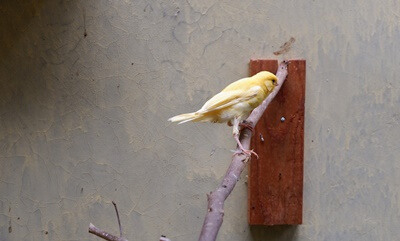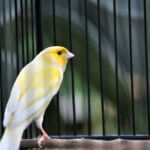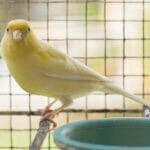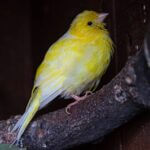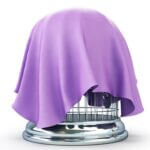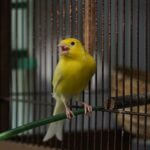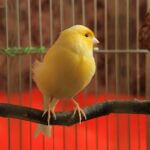Canaries can become infected by external parasites, which transmit diseases and cause severe damage to the skin, plumage, beaks, and feet.
The most common parasite that affects canaries is the scaly leg mite, also known as the scaly face mite. As the name implies, these are the two most commonly affected areas. They survive by lodging themselves in the host’s body and drawing nutrients directly from them.
These parasites are treatable, and any damage is reversible if caught early.
What Are Scaly Leg Mites?
Scaly leg mites, scientifically known as knemidokoptes mutans, are microscopic organisms that infect canaries, budgies, finches, and other varieties of pet birds. These parasites burrow into the unfeathered parts of a canary’s body and feed on keratin.
According to the Journal of Parasitic Diseases, this can result in the growth of scaly tissue around the legs of the affected bird. This, naturally, gives the parasite its iconic name.
In more extreme cases, the scaly leg mites can also infect a bird’s beak or facial area, causing it to take on a crusty, honeycombed appearance. These are then referred to as face mites.
While scaly leg mites can attack birds of all ages, younger birds are the most affected due to their weaker immune system. That said, infestation by leg mites can be painful and uncomfortable for any bird, regardless of age and health status.
Are Scaly Leg Mites Contagious?
Rough physical contact can transmit scaly leg mites from infected birds to healthy ones. Newly hatched birds can contract the parasites through direct exposure to infected parents or from their nests.
Canary chicks are more prone to mites since they have little to no feather coverage on their skin, making it easier for parasites to latch on.
Despite having mites, birds with a robust immune system may not exhibit clinical symptoms.
Therefore, if you have multiple canaries in a shared cage or aviary, these parasites may spread or return, even after treating those most obviously affected. This could result from an asymptomatic bird, making it sensible to treat all your birds.
Signs Of Scaly Leg Mites
Symptoms of scaly leg mites can vary, depending on the bird. Usually, canaries will manifest:
- White, chalky, or crusty beak
- Honeycomb appearance around the facial area
- White, crusty, and scaly feet
- Beak deformities, such as elongation and curving
- Lameness
- Difficulty walking
If the condition remains untreated, it can progress into “tassel foot.”
This more advanced form of the scaly leg causes tassels of deformed keratin scales to grow on the bottom and sides of the affected canary’s feet. This is not only visually upsetting but painful.
Diagnosing Scaly Leg Mites
If you suspect your canary has scaly leg mites, have it examined by a specialized avian vet. An expert can then rule out the possibility of underlying health issues beyond parasites.
For example, the vet will run a series of tests, including blood work and serum analysis, to determine if the cause is nutritional deficiencies, not parasites.
Your vet will also remove a sample of the affected skin and observe it under a microscope to see if there are any cnemidocoptes mites or their eggs.
If these are present, your vet will diagnose scaly leg mites positively.
Treating Scaly Leg Mites
Once the vet has confirmed that your canary is infected with scaly leg mites, they may prescribe different medications to eradicate the parasites.
If you have more than one canary in your home, they’ll need to be treated, whether they’re exhibiting symptoms or not. Professional treatments include:

Ivermectin
According to Ivermectin and Abamectin, ivermectin is a potent antiparasitic medication that should be given in small doses to little animals like canaries.
It’s commonly used to treat many parasitic worms, such as whipworms, hookworms, and heartworms. It’s also the first line of treatment for scaly leg mites and other external parasites in birds.
Your vet will prescribe an initial treatment for ten days, after which you will be required to bring in your canary for an examination to track the progress of the treatment.
It can take 2-6 treatments (10 days each) to completely eradicate the scaly leg mites. So, monitoring how well your canary responds to the treatment at every stage is important.
Ivermectin can be applied topically on the skin of the infected bird. The best areas to apply the medication are on your bird’s jugular vein (the vein around the neck) and around the shoulder blades.
Topical application is highly effective since the skin absorbs the medication relatively quickly, which is easier for birds than ingestion.
If you’re treating many canaries, and the topical application isn’t practical, you may administer the medication through your pet’s drinking water.
Do this by mixing 1 ml. of ivermectin per liter of water. Be aware this method may not be as effective as a topical application since ivermectin precipitates quickly when mixed with water. So, if you do decide to go this route, you’ll have to be strategic in your approach.
Ideally, you should add ivermectin to your canaries’ drinker in the morning since they will be thirstier at this time. They may drink it before it precipitates and loses its efficacy.
Antibiotics
When treating your canary for scaly leg mites, your vet might also recommend using antibiotics to manage the risk of secondary infections.
This is because the lesions on your canary’s face and legs are susceptible to rupturing and weeping, leaving your canary vulnerable to a host of bacteria.
The precise medication suggested will depend on the type of wounds your canary has and the bacteria your vet identifies as risk factors.
DIY Methods For Treating Scaly Leg Mites In Canaries
If your canary has an early or minor case of scaly leg mites, it may be helpful to try at-home remedies.
They can work as a method of treating your canary while you wait for your vet’s appointment. Doing so will provide relief for your canary at the least and may resolve a minor case of mites at best.
Remember that you should not use this instead of professional advice. If scaly leg mites are allowed to run out of control, they can leave permanent damage.
Petroleum Jelly
The most common home remedy for scaly leg mites involves petroleum jelly, such as Vaseline.
Apply a thin layer of jelly on the affected bird’s beak, cere, and legs for about ten days. Don’t cover your bird’s nostrils or put it inside the beak.
While the jelly doesn’t kill the scaly leg mites instantly, it suffocates them over time while softening the crusty layers they leave. That makes the parasites easier to remove from the bird’s legs and face.
Of course, this isn’t as effective as the use of ivermectin. Applying enough petroleum jelly regularly to suffocate all the mites properly is difficult.
Likewise, you may not catch all the mites since they can’t be observed with the human eye, so they may infect other parts of your bird that you haven’t noticed.
Petroleum jelly will make your canary greasy with clumping feathers, causing your bird serious discomfort. This is only meant to be a last-ditch effort as you wait for a vet.
Vinegar
Vinegar offers a non-toxic remedy for managing scaly leg mites in canaries. To use this home treatment, soak your canary’s feet in warm soapy water for a few minutes, then rinse and dry them.
Next, dip an old toothbrush in vinegar and use it to scrub your canary’s legs. Just like petroleum products, vinegar will suffocate them over time.
How Long Does It Take To Kill Scaly Leg Mites?
It can take 2-3 weeks for scaly leg mites to be completely eradicated from an affected bird, provided treatment is done consistently.
As the treatment progresses, the condition’s symptoms will gradually begin to dissipate.
For instance, the inflammation will start to decrease, the scales on the affected bird’s feet will start to look normal again, and the damaged skin will flake off and be replaced with fresh, new layers.
Prevention of Scaly Leg Mites In Canaries
According to Animal Health and Forestry, canaries are less likely to die from a scaly leg mite infestation. However, the infestation may cause serious health problems that can reduce your pet’s quality of life.
For this reason, take precautionary measures to prevent your canaries from becoming infected in the first place. Here are ways to avoid scaly leg mites:
Maintain Hygiene In Your Canary’s Cage
Parasites are often contracted through feces, shared food, or contact with sick birds. You can eliminate most of these issues by regularly maintaining your canary’s cage.
Be sure to lightly clean and disinfect the enclosure at least once a day, with a deep clean once a week. Be sure to use bird-safe disinfectants.
Provide A Bird Bath
Canaries, like most songbirds, like to bathe regularly because this helps them cool their bodies during hot weather and removes any dust and debris that might be trapped under their feathers.
The cleaner your bird is, the healthier it will be, and the better it can repel mites.
Adding a few drops of apple cider vinegar to your canaries’ bird bath helps repel these parasites while keeping your canaries’ plumage bright and pristine.
Regularly Monitor Health and Behavior
Be vigilant about any unusual physical and behavioral changes in your canary, no matter how small they may seem.
For instance, if you notice that your canary is suddenly pruning itself too frequently or losing feathers, this can be an early sign of external parasites. The earlier you detect the signs, the easier it’ll be to treat.

